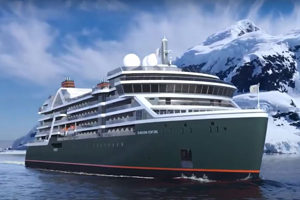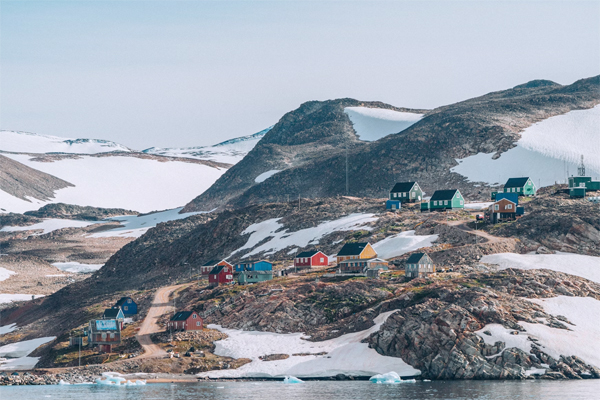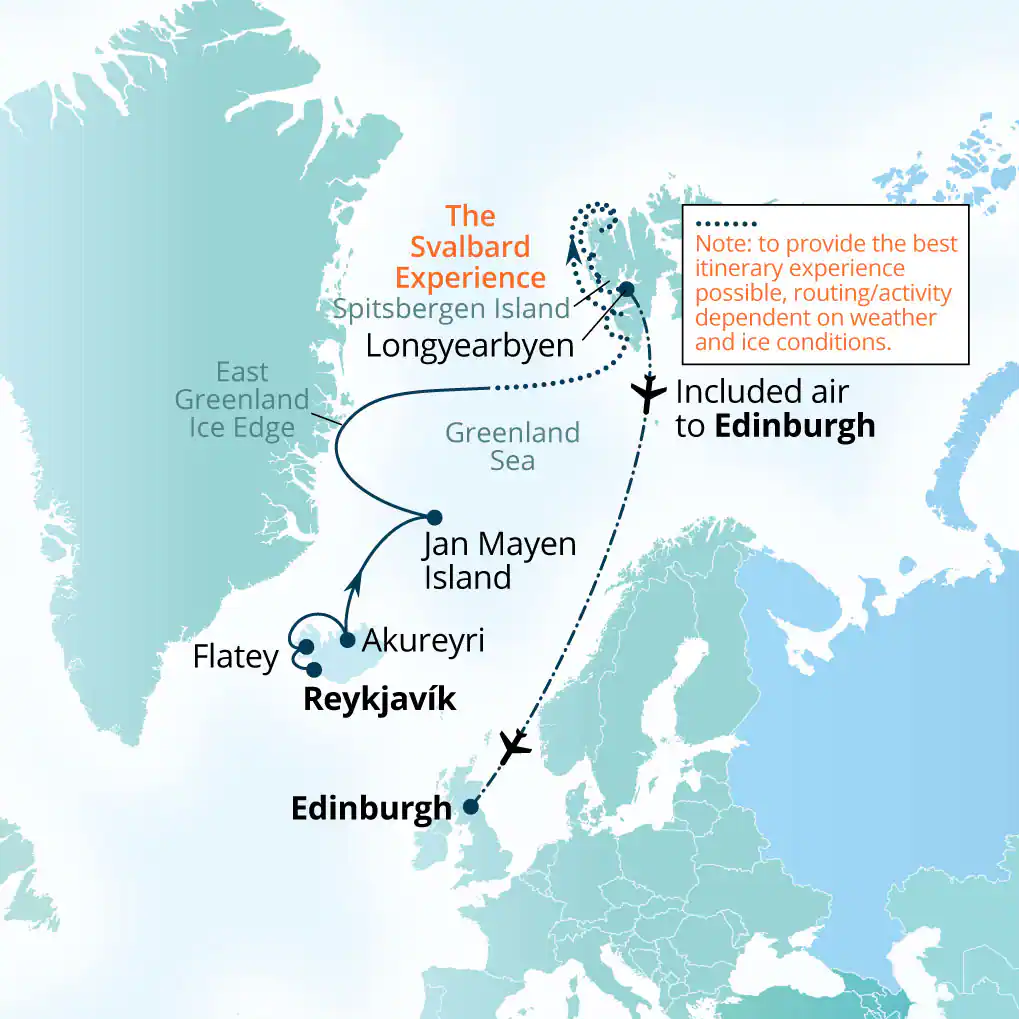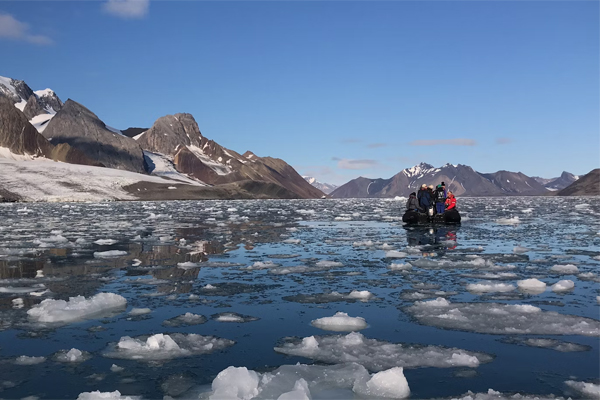DATES / RATES
Rates are listed per person
|
| Start Date | End Date | From EUR | From USD |
|---|
| May 18, 2025 | May 31, 2025 | 10,331 |
11,699 |
| Jun 06, 2025 | Jun 19, 2025 | 11,126 |
12,599 |
Rates are listed per person
|
| Start Date | End Date | From EUR | From USD |
|---|
| May 18, 2025 | May 31, 2025 | 10,331 |
11,699 |
| Jun 06, 2025 | Jun 19, 2025 | 11,126 |
12,599 |
ITINERARY
Day
0 : Reykjavik, Iceland
Reykjavík,
established by Viking settler Ingólfur Arnarson around 870
C.E, is the location of the first permanent settlement in Iceland. The
census of 1703 recorded that Reykjavík had 69 residents and
consisted of a farm and a church. The impressive statue of Leif
Erikson, in the center of town, reminds all of Iceland’s
Viking heritage. Its name translates to ‘smoky
bay’, due to the geothermal nature of the surrounding area.
Today
about 200.000 people live in the Icelandic capital, roughly 60% of the
country’s population. It has evolved into a sophisticated
city. The northernmost national capital in the world is also one of the
cleanest, greenest, and safest on Earth. Walking Reykjavik
streets one will find rich culture, history, music, shopping and in the
late hours vibrant night-life. Colorful rooftops and the elegant spire
of Hallgrímskirkja Church dominate Reykjavik’s
skyline. Known for its arts, Reykjavik hosts a number of
internationally recognized festivals, notably the Iceland Air music
festival, Reykjavik Arts Festival and the Reykjavik International Film
Festival.
Day
1 : Flatey, Iceland
The
remote island of Flatey is located in Breidafjörður
Bay on the northwestern part of Iceland. “Flat
Island” is 2 km long and 1 km wide has only one road through
the quaint little old village. Sheep and seabirds are the most numerous
inhabitants, including large numbers of Atlantic puffins and Arctic
terns. The island is a paradise for bird watching with over 30
different species during the breeding season.
Day
2 : Akureyri, Iceland
Akureyri
is the second largest urban area in Iceland with a population of around
18,000. Nicknamed ‘The Capital of the North,’ it is
situated at the head of Eyjafjörður, the longest fjord
in Iceland, only 62 miles (100 km) from the Arctic Circle. Surrounded
by snow-streaked mountains, the Akureyri hills flourish in summer with
a profusion of arctic wildflowers. Mt. Kerling is the highest peak
visible from town, at 5,064’ (1,538 m). Often cloudy, with a
mild climate, Akureyri has much less precipitation than its southern
counterpart Reykjavik. It is a cultured city, with a university,
numerous galleries, museums, art exhibitions, and live theater
performances.
Nearby
Hrísey Island is a spectacularly beautiful and peaceful
island often called ‘The Pearl of
Eyjafjörður,’ with an atmosphere of calm and
settled tranquility. Numerous Atlantic puffins fly overhead, and the
occasional whale is seen traversing the fjord.
Day
3 : Days At Sea
Day
4 : Jan Mayen Island, Norway
Remote
and isolated, Jan Mayen is dominated by 2,277 meter (7,470’)
high Beerenberg Volcano and its large ice cap. The island has two
parts: larger northeast Nord-Jan and smaller southwest
Sør-Jan, linked by a 2.5 kilometer (1.6 mile) wide isthmus.
The League of Nations gave jurisdiction of Jan Mayen to the Kingdom of
Norway in 1921. Except for being used as a meteorological, radio and
navigation aid for shipping in the Atlantic, the island has remained
untouched, its only inhabitants are 18 military personnel.
In
2010 Jan Mayen was declared a nature reserve for the protection of its
wildlife and is recognized as one of the most important breeding sites
for over 250,000 seabirds in the North Atlantic. It supports large
colonies of northern fulmars, little auks and thick-billed
guillemots. Polar bears found here are genetically distinguishable from
those found elsewhere.
Although
‘officially’ discovered by the Dutch whaling
captain Fopp Gerritsz in 1614, it may have been sighted by exploring
Irish monks as early as A.D. 400.
Day
5 : Exploring East Greenland Ice Edge
Towering
glaciers meet the restless sea, creating a mesmerizing landscape of
contrasts at East Greenland"s Ice Edge. Witness colossal icebergs
calving from the glacier fronts, while keeping an eye out for wildlife
such as seals and seabirds. Experience the profound tranquility of this
remote wilderness amidst the frozen majesty of the ice edge.
Day
6 : Days At Sea
Day
7-10 : Svalbard Experience
Svalbard
is a remote, vast and wild place, largely untouched by the human
presence. In visiting this destination, our plans and itinerary are not
set, as we allow the weather, conditions and wildlife to dictate each
day. Should a polar bear appear on the horizon we might stop the ship
or the Zodiacs in order to get a better look at it. Should ice choke
the waters in front of us, we might slow down and explore the edge of
this ice while admiring its colors and forms while searching for
wildlife, or else turn and choose another destination. Should storms
lash against the site we want to visit, we may opt to find a more
protected bay and explore a different spot. Whatever we do Svalbard
holds many beauties and mysteries and exciting discoveries are always
available for those whose eyes and hearts are open.
Day
12 : Longyearbyen, Norway
Longyearbyen,
the seat of the Governor of Svalbard, is located in a narrow valley
along the shores of Adventfjorden a small tributary of Isfjord, the
largest fjord system in Svalbard. It extends 100 kilometers (60 miles)
into the island of Spitsbergen. Nine large tidewater glaciers, with a
combined ice-front of 21 kilometers (13 miles), as well as dozens
hanging glaciers drain into the fjord.
The
town’s 2,100 inhabitants exist in one of the most northern
settlements on Earth, making their living by a combination of coal
mining, education and tourism. Because of the town’s extreme
isolation, proximity to wildlife, and Svalbard’s pristine
environment, unique laws exist that are found in few other places. All
individuals venturing outside of town are required to carry a rifle for
protection against polar bears, possessing a cat is illegal, no one is
allowed to be buried here and how much alcohol can be purchased each
month is restricted.
Longyearbyen
was named after the American industrialist John Longyear whose Arctic
Coal Company began mining here in 1906.
Day
12-13 : Edinburgh, Scotland, UK
Edinburgh,
the capital of Scotland, is a city that effortlessly combines ancient
history with a vibrant modern energy. Its streets are steeped in
stories, from the cobblestones of the Old Town to the elegant Georgian
avenues of the New Town, both recognized as UNESCO World Heritage
Sites. Visit Edinburgh Castle, majestically poised atop an ancient
volcanic rock, and stroll the Royal Mile leading to the regal Palace of
Holyroodhouse. Discover world-class art at the Scottish National
Gallery and find serenity in the Princes Street Gardens. Marvel at the
contemporary Scottish Parliament building, tour the decommissioned
Royal Yacht Britannia, and when night falls, immerse yourself in
Edinburgh's thriving cultural scene.
Seabourn Venture (Luxury Expedition, 264-guests)
Seabourn Venture is Seabourn's ultra-luxury purpose-built expedition ship. The ship features 132 all veranda, all ocean-front suites. The ship is built for polar environments (PC6 Polar Class standards) with a brand new innovative design, created specifically for the ultra-luxury expedition traveler. There are two custom-built submarines onboard, providing an unforgettable view of the world beneath the ocean's surface. The ship is also designed to carry a complement of double sea kayaks as well as 24 Zodiacs that can accommodate all onboard guests at once.
 (Click image to view Ship details)
(Click image to view Ship details)
WHAT'S INCLUDED
Please Call Us to find out what is included in the fare
ADVENTURE
OPTIONS
- Hiking
- Kayaking
- Cultural
Tour
- Zodiac
Cruising










